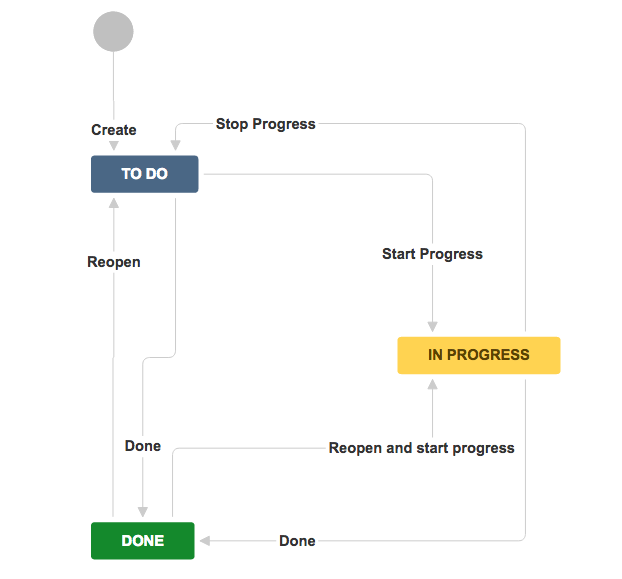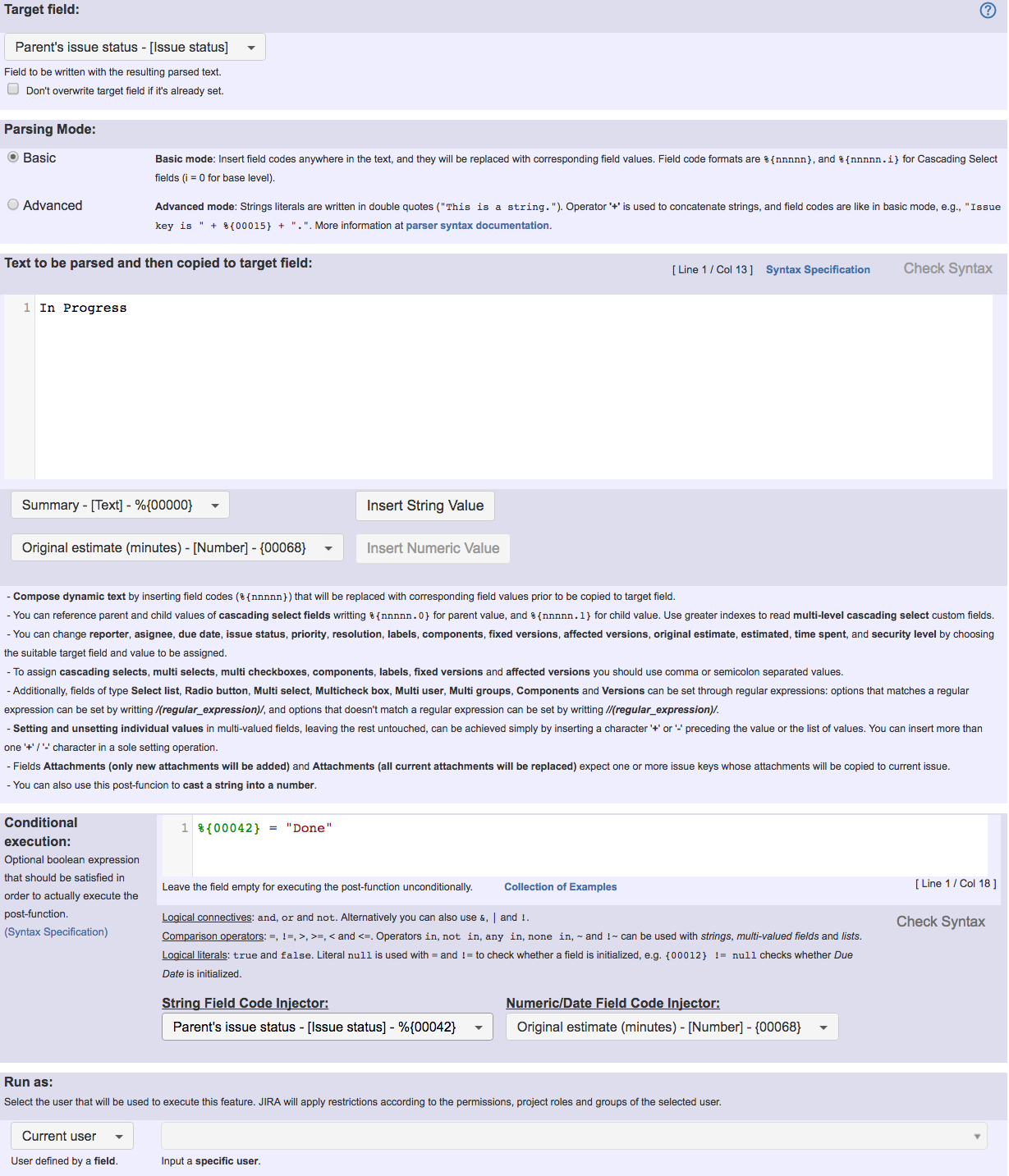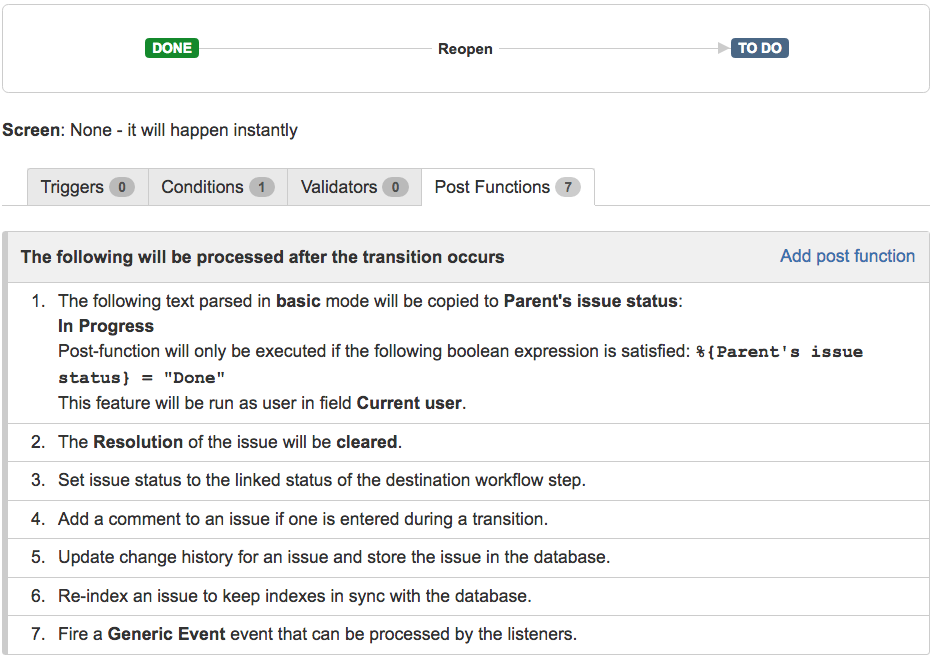Features used to implement the example
A sub-task can execute a post-function in order to move its parent issue through the workflow. For example, we can close a parent issue when all sub-tasks are closed.
How to make parent issue progress through its workflow?
A sub-task can make its parent issue transition using 2 different sets of virtual fields:
- "Parent's issue status" and "Parent's issue status (delayed writing)": if we write the name of a status (e.g., Open, In Progress, Closed, ...) into any of these 2 virtual fields, the plugin will look for transitions in parent's workflow going from parent's current status to a status with the same name as the one we have written. If a suitable transition is found and its conditions and validations are satisfied, the transition will be executed, and parent issue will be moved to entered status.
- "Execute transition on parent issue" and "Execute transition on parent issue (delayed execution)": if we write the name of a transition (e.g., Start Progress, Close Issue, ...) into any of these 2 virtual fields, the plugin will look for a transition in parent's workflow departing from parent's current status with the entered name. If that transition exists and its conditions and validations are satisfied, the transition will be executed.
In order to transition parent issue, a sub-task typically uses post-function Copy parsed text to a field with the following configuration:
- Target field: any of the 4 virtual fields above described.
- Parsing mode: basic
- Text to be parsed...: the name of a status or the name of a transition, depending of the selected target field.
Also Set a field as a function of other fields can be used.
Difference between "Parent's issue status" and "Parent's issue status (delayed writing)" or "Execute transition on parent issue" and "Execute transition on parent issue (delayed execution)"
Virtual fields "Parent's issue status" and "Execute transition on parent issue" try to transition parent issue as soon as they are written, while fields "Execute transition on parent issue (delayed execution)" and "Execute transition on parent issue (delayed execution)" wait for sub-task's current transition to end execution, before transitioning parent issue.
When a sub-task uses "Execute transition on parent issue (delayed execution)" or "Execute transition on parent issue (delayed execution)" fields for transitioning its parent issue, parent's execution attempt won't be carried out until current sub-task's transition has finished, and thus sub-task is in the new status. For this reason, these fields are used when parent issue is blocked by a condition or validator depending on sub-tasks statuses, typically by a conditions or validators like "Sub-Task Blocking Condition", Condition and validation on sub-tasks and Boolean condition and validator with math. date-time or text-string terms, etc.
Example: Reopen parent issue when a sub-task is reopened
In this example we show how to automatically reopen an issue in status "Done" when any of its sub-tasks is reopened. Let's assume the following workflow:
We will insert post-function Copy parsed text to a field into transitions "Reopen" and "Reopen and start progress" with the following configuration:
Note that:
- %{00042} is field code for Parent's issue status
- We haven't written the name of the statuses in upper case, but like In Progress and Done, because Jira UI typically shows the name of statuses in upper case, while the actual names are not. You can check up the actual names at Jira Administration screens
Once configured, transitions "Reopen" and "Reopen and start progress" will look like this:
Other examples of that function
- Add all assignees of certain sub-task types to a "Multi-User Picker" custom field
- Add and remove a single or a set of items from multi valued fields
- Add current user to comment
- Add or remove request participants
- Add watchers from a part of the issue summary: "Summary_text - watcher1, watcher2, watcher3, ..."
- Assign issue based on the value of a Cascading Select custom field
- Assign issue to last user who executed a certain transition in the workflow
- Automatically close resolved sub-tasks when parent issue is closed
- Automatically reopen parent issue when one of its sub-tasks is reopened
- Calculate the time elapsed between 2 transition executions
- Close parent issue when all sub-tasks are closed
- Combine the values of several Multi-User picker fields
- Compose a parsed text including the "full name" or a user selected in a User Picker custom field
- Compose dynamic text by inserting field values in a text template
- Copy issue labels to a custom field
- Copy the value of a user property into a user picker
- Create a comment in sub-tasks when parent transitions
- Execute transition in epic
- Getting the number of selected values in a custom field of type Multi Select
- Limit the number of hours a user can log per day
- Make a sub-task's status match parent issue's current status on creation
- Make parent issue progress through its workflow
- Moving story to "In Progress" when one of its sub-tasks is moved to "In Progress"
- Moving story to "Ready for QA" once all its sub-tasks are in "Ready for QA" status
- Parse Email adresses to watchers list
- Parsing text from last comment and appending it to issue's summary
- Remove versions selected in a version picker custom field
- Replace certain issue link types with different ones
- Restrict parent issue from closing if it has sub-tasks that were created during a given parent issue status
- Set a Select or Multi-Select field using regular expression to express the values to be assigned
- Set assignee depending on issue type
- Set field depending on time passed since issue creation
- Set priority for issues that have been in a certain status for longer than 24 hours
- Set security level based on groups and project roles the reporter or creator are in
- Transition linked issues in currently active sprint
- Transition only a sub-task among several ones
- Transition parent issue only when certain issue sub-task types are done
- Update Cascading Select custom field with a value of the field in parent issue
- Update checkboxes custom field if a file has been attached during a transition
- Validation on issue attachments
- Validation on MIME types of issue attachments
- Writing a comment to blocked issues when blocking issues are resolved


